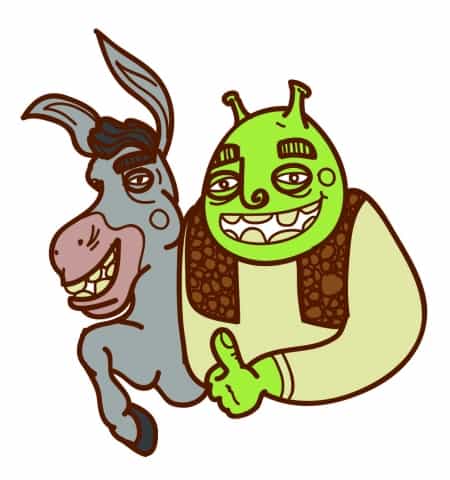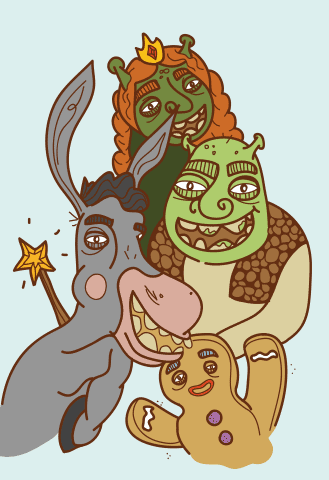
Few films carry the cultural resonance that the Shrek films do. From the infamous Shrek is Love, Shrek is Life series to Swamp Sim inspired by The Slender Man to the post-ironic resurgence of Smash Mouth’s “All Star,” Shrek continues to occupy a place in our lives.
Since the release of the first Shrek film in 2001, the series has exploded to include four feature-length films, a plethora of side-stories, a host of video games and even a musical. With the series’ fifth installment in the works, it’s clear that Shrekmania shows no signs of stopping. So, I decided to get to the bottom of this cultural obsession with Shrek in the only truly appropriate way — by staging a Shrek marathon.
The plan for the Shrekathon was simple: I would watch what Netflix supplied of DreamWorks Pictures’ Shrek filmography in one day — a mission that meant consuming nearly 10 hours of Shrek content. Though this Shrekathon was a considerable undertaking, it was something that I knew I had to do.
On the morning of Nov. 15, the Shrekathon began with a viewing of the original Shrek film. Simply put, Shrek is deservedly an iconic work. It boasts an infinitely quotable script, a convention-breaking narrative, a swamp-load of quality jokes, a cast of talented voice actors and a killer soundtrack — you can’t really beat having “Hallelujah” and “All Star” in the same movie.
Despite these obvious reasons to love Shrek, the film has not aged well visually. Shrek and company are fuzzy figures set against flat, boring backgrounds — making the film seem less than dynamic. However, these graphics are to be expected from a film released in 2001. Besides this, the film holds up extraordinarily well in 2017.
If Shrek’s style broke new ground, then Shrek 2 perfected the technique. Like the original, Shrek 2 has a stellar score, great jokes and a compelling story arc. Thematically, the two movies are identical — they both follow Shrek’s struggle to deal with intolerance and his difficulties with learning to accept who he is.
Shrek the Third is where the Shrekathon started to take a turn for the worse. In comparison to the first two movies, Shrek the Third has fewer jokes land, fewer references in general and a rather lackluster soundtrack. More than anything, Shrek the Third just feels tired.
The 2010 film Shrek Forever After — which misses the opportunity to jump on a “four-ever” excellent title pun — is certainly the darkest entry in the franchise. Though emotionally compelling and unexpectedly somber, Shrek Forever After just regurgitates the series’ stale “true love’s kiss” motif to solve the narrative tension, making the film feel like a poor attempt to conjure the same magic that the first two Shreks brought to the table.
In addition to the core Shrek films, some DreamWorks shorts were also part of the Shrekathon. However, these shorts — Scared Shrekless, Far Far Away Idol, The Ghost of Lord Farquaad and Shrek the Halls — are largely derivative and uninspired. Since each short has a runtime of under thirty minutes, they needed to be concise. This unfortunately means that they just focus on Shrek’s perpetual grumpiness and his inability to accept change — a repetition of every other Shrek work.
Shrek the Musical was the final part of the Shrekathon — and easily the worst of all. To give you an idea, Brian d’Arcy James, who plays Shrek, cannot maintain a consistent accent. Moreover, the musical is bereft of all the songs that people love from Shrek, except for an over-the-top rendition of “I’m a Believer” at the end of the movie, as if to absolve the film from its otherwise disappointing sonic roster.
At best, Shrek the Musical feels like a half-baked piece of grotesque fanfiction. At worst, it’s an unforgivable bastardization of what made the original Shrek great. If anything, Shrek the Musical reveals the worst ways that the Shrek series can be used.

When I completed the Shrekathon, it became clear to me that the widespread obsession with Shrek is frequently centred around the first two films. I think that part of the reason why we hear more about the layered onions from Shrek than about the communist undertones of Shrek Forever After, for instance, is because Shrek and Shrek 2 are the most culturally porous compared to the other installments in the franchise.
Between the topical soundtracks, the many references to fairy tales and films, and the incessant visual homages, the first two Shrek films are cross-cultural reference keys of sorts. After Shrek 2, the series loses its emphasis on cultural happenings, more broadly — and in the process, it lost much of its mimetic potential.
Moreover, I think that nostalgia plays a major role in the perpetual relevance of Shrek. Many of us twenty-somethings were children when Shrek and Shrek 2 were released, so these movies are deeply ingrained in our memories. This familiarity has established Shrek as a template for jokes and ideas, while remaining accessible. Sometimes the things that hit us first hit us the hardest.
At the end of the day, we could pick a worse series to have a small obsession over. At its core, the Shrek franchise is about love and about life. These works encourage us to love ourselves and those around us. They tell us to embrace the changes that come our way. As far as advice goes, I think this is pretty applicable nowadays.
But between the Shrekathon, writing this article, and listening to “All Star” basically every day, I don’t think I’m alone in saying that I need a break from Shrek — I’m swamped.
—
Tanner Bayne / Culture Editor
Graphic: Lesia Karalash / Graphics Editor